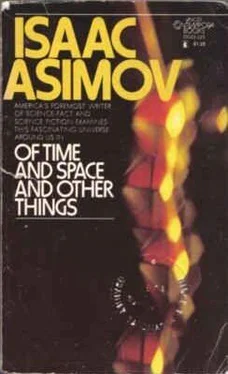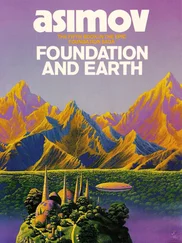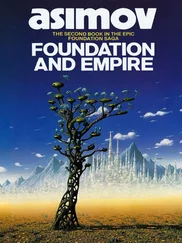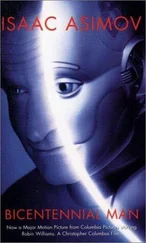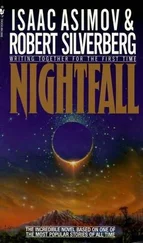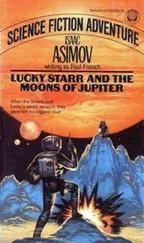Isaac Asimov - Of Time and Space and Other Things
Здесь есть возможность читать онлайн «Isaac Asimov - Of Time and Space and Other Things» весь текст электронной книги совершенно бесплатно (целиком полную версию без сокращений). В некоторых случаях можно слушать аудио, скачать через торрент в формате fb2 и присутствует краткое содержание. Год выпуска: 1972, ISBN: 1972, Издательство: Lancer Books, Жанр: Прочая научная литература, на английском языке. Описание произведения, (предисловие) а так же отзывы посетителей доступны на портале библиотеки ЛибКат.
- Название:Of Time and Space and Other Things
- Автор:
- Издательство:Lancer Books
- Жанр:
- Год:1972
- ISBN:ISBN: 0-447-33023-3
- Рейтинг книги:4 / 5. Голосов: 1
-
Избранное:Добавить в избранное
- Отзывы:
-
Ваша оценка:
- 80
- 1
- 2
- 3
- 4
- 5
Of Time and Space and Other Things: краткое содержание, описание и аннотация
Предлагаем к чтению аннотацию, описание, краткое содержание или предисловие (зависит от того, что написал сам автор книги «Of Time and Space and Other Things»). Если вы не нашли необходимую информацию о книге — напишите в комментариях, мы постараемся отыскать её.
Of Time and Space and Other Things — читать онлайн бесплатно полную книгу (весь текст) целиком
Ниже представлен текст книги, разбитый по страницам. Система сохранения места последней прочитанной страницы, позволяет с удобством читать онлайн бесплатно книгу «Of Time and Space and Other Things», без необходимости каждый раз заново искать на чём Вы остановились. Поставьте закладку, и сможете в любой момент перейти на страницу, на которой закончили чтение.
Интервал:
Закладка:
Since the Sun governs the day-unit, it seems natural to turn to the next most prominent heavenly body, the Moon, for another unit. One offers itself at once, ready-made the period of the phases. The Moon waxes from nothing to a full Moon and back to nothing in a definite period of time. This period of time is called the "month" in English
(clearly from the word "mooif') or, more specifically, the
"lunar month," since we have other months, representing periods of time slightly shorter or slightly longer than the one that is strictly tied to the phases of the moon.
The lunar month is roughly equal to 291/2 days. More exactly, it is equal to 29 days, 12 hours, 44 minutes, 2.8 seconds, or 29.5306 days.
In pre-agricultural times, it may well have been that no, special significance attached itself to the month, which re mained only a convenient device for measuring moderately long periods of time. The life expectancy of primitive man was probably something like 350 months, which is a much more convenient figure than that of I 1,000 days.
In fact, there has been speculation that the extended lifetimes of the patriarchs reported in the fifth chapter of the Book of Genesis may have arisen out of a confusion of years with lunar months. For instance, suppose Me thuselah had lived 969 lunar months. This would be just about 79 years, a very reasonable figure. However, once that got twisted to 969 years by later tradition, we gained the "old as Methuselah" bit.
However, I mention this only in passing, for this idea is not really taken seriously by any biblical scholars. It is much more likely that these lifetimes are a hangover from
Babylonian traditions about the times before the Flood.
…But I am off the subject.
It is my feeling that the month gained a new and enhanced importance with the introduction of agriculture.
An agricultural society was much more closely and pre cariously tied-to the season amp; than a hunting or herding society was. Nomads could wander in search of grain or grass but farmers had to stay where they were and hope for rain. To increase their chances, farmers had to be cer tain to sow at a proper time to take advantage of sea sonal rains and seasonal warmth; and a mistake in the sowing period might easily spell disaster. What's more, the development of agriculture made possible a denser popu lation, and that intensified the scope of the possible dis aster.
Man had to pay attention, then, to the cycle of seasons, and while he was still in the prehistoric stage he must have noted that those seasons came fall cycle in roughly twelve months. In other words, if crops were planted at a par ticular time of the year and all went well, then, ff twelve months were counted from the first planting and crops were planted again, all would again go well.
Counting the months can be tricky in a primitive so ciety, especially when a miscount can be ruinous, so it isn't surprising that the count was usually left in the hands of a specialized caste, the priesthood. The priests could not only devote their time to accurate counting, but could also use their experience and skill to propitiate the gods.
After all, the cycle of the seasons was by no, means as rigid and unvarying as was the cycle of day and night or the cycle of the phases of the moon. A late frost or a failure of rain could blast that season's crops, and since such flaws in weather were bound to follow any little mista e in ritual (at least so men often believed), the priestly func tions were of importance indeed.
It is not surprising then, that the lunar month grew to have enormous religious significance. There were new
Moon festivals and special priestly proclamations of each one of them, so that the lunar month came to be called the "synodic month."
The cycle of seasons is called the "year" and twelve lunar months therefore make up a "lunar year." The use of lunar years in measuring time is referred to as the use of a "lunar calendar." The only important group of people in modem times, using a strict lunar calendar, are the Moh ammedans. Each of the Moharmnedan years is made up of 12 months which are, in turn, usually made up of 29 and 30 days in alternation.
Such months average 29.5 days, but the length of the true lunar month is, as I've pointed out, 29.5306 days.
The lunar year built up out of twelve 29.5-day months is 354 days long, whereas twelve lunar months are actually 354.37 days long.
You may say "So what?" but don't. A true lunar year should always start on the day of the new Moon. If, how ever, you start one lunar year on the day of the new Moon and then simply alternate 29-day and 30-day months, the third year will start the day before the new Moon, and the sixth year will start two days before the new Moon. To properly religious people, this would be unthinkable.
Now it so happens that 30 true lunar years come out to be almost exactly an even number of days-10,631.016.
Thirty years built up out of 29.5-day months come to
10,620 days-just 1 1 days short of keeping time with the
Moon' For that reason, the Mohammedans scatter 1 1 days through the 30 years in some fixed pattern which prevents any individual year from starting as much, as a full day ahead or behind the new Moon. In each 30-year cycle there are nineteen 354-day years and eleven 355-day years, and the calendar remains even with the Moon.
An extra day, inserted in this way to keep the calendar even with the movements of a heavenly body, is called an
"intercalary day"; a day inserted "between the calendar," so to speak.
The lunar year, whether it is 354 or 355 days in length, does not, however, match the cycle of the seasons. By the dawn of historic times the Babylonian astronomers had noted that the Sun moved against the background of stars
(see Chapter 4). This passage was followed with absorp tion because it grew apparent that a complete circle of the sky by the Sun matched the complete cycle of the seasons closely. (This apparent influence of the stars on the sea sons probably started the Babylonian fad of astrology which is still with us today.)
The Sun makes its complete cycle about the zodiac in roughly 365 days, so that the lunar year is'about II days shorter than the season-cycle, or "solar year." Three lunar years fall 33 days, or a little more than a full month be hind the season-cycle.
This is important. If you use a lunar calendar and start it so that the first day of the year is planting time, then three years later you are planting a month too soon, and by the time a decade has passed you are planting in mid winter. After 33 years the first day of the year is back where it is supposed to be, having traveled through the entire solar year.
This is exactly what happens in the Mohammedan year. The ninth month of the Mohammedan year is named
Ramadan, and it is especially holy because it was the month in which Mohammed began to receive the revela tion of the Koran. In Ramadan, therefore, Moslems ab stain from food and water during the daylight hours.
But each year, Ramadan falls a bit earlier in the cycle of the seasons, and at 33-year intervals it is to be found in the hot season of the year; at this time abstaining from drink is particularly wearing, and Moslem tempers grow particularly short.
The Mohammedan years are numbered from the Hegira; that is, from the date when Mohammed fled from Mecca to Medina. That event took place in A.D. 622. Ordinarily, you nught suppose, therefore, that to find the number of the Mohammedan year, one need only subtract 622 from the number of the Christian year. This is not quite so, since the Mohammedan year is shorter than ours. I write this chapter in A.D. 1964 and it is now 1342 solar years since the Hegira. However, it is 1384 lunar years since the
Hegira, so that, as I write, the Moslem year is A.H. 1384.
Читать дальшеИнтервал:
Закладка:
Похожие книги на «Of Time and Space and Other Things»
Представляем Вашему вниманию похожие книги на «Of Time and Space and Other Things» списком для выбора. Мы отобрали схожую по названию и смыслу литературу в надежде предоставить читателям больше вариантов отыскать новые, интересные, ещё непрочитанные произведения.
Обсуждение, отзывы о книге «Of Time and Space and Other Things» и просто собственные мнения читателей. Оставьте ваши комментарии, напишите, что Вы думаете о произведении, его смысле или главных героях. Укажите что конкретно понравилось, а что нет, и почему Вы так считаете.
